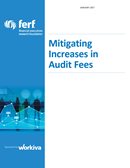
Despite pressure on audit fees from regulatory requirements, inflation or other factors, many companies have found ways to mitigate or even reduce audit fee increases.
According to FERF’s 2016 Annual Audit Fee Report, a review of SEC filings by MyLogIQ found that in the 2015 audit year, 1,166 filers of 6,490 reviewed (or 18 percent) were able to reduce their audit fees from the previous year.
In a new report, Mitigating Increases in Audit Fees, FERF interviewed preparers and auditors to learn how companies can reduce audit fees, or at least mitigate potential increases.
For example, a controller at a technology manufacturer said although asking for a rate reduction was unlikely to be successful, taking on some of the data preparation work being performed by his company’s external auditor helped reduce the number of hours his company was billed for, and the overall expenses.
Other recommendations from interviewees include:
- Rethink the business and centralize business processes: Audit fees are often related directly to the size and complexity of the business, so if any parts of the business are sold or discontinued, audit fees should decline in proportion.
- Align key controls with key risks: Public Company Accounting Oversight Board (PCAOB) inspections have encouraged auditors to spend more time reviewing management controls during the annual audit, prompting registrants to align key controls with the most relevant risks.
- Document internal controls: If a company has very light or poorly organized documentation, or hasn’t thought through all the branches in a process, attestation becomes difficult for the auditor — and more costly for the registrant.
- Consider outsourcing internal audit: A Big Four audit firm may be able to rely on the internal audit work of a regional firm with a significantly lower hourly rate.
- Communicate with the auditor: Good communication should be continual through the process, not limited to the start or end of the audit.
- Evaluate the latest technology: External and internal auditors are both using data analytics technology to increase audit quality, work smarter and potentially reduce costs.
Improving the alignment of controls with a company’s key risks, and reviewing those controls on a consistent basis, are among the most helpful factors in reducing audit fees or mitigating fee increases.
For instance, Eric Miles, a partner at Moss Adams, says risk assessment is the cornerstone of an effective compliance program, because identifying risk leads to control design and, in turn, documentation and testing.
It’s also important to review those controls on a routine basis, since risks are subject to changes in business and market conditions. The report quotes the chief accounting officer for a real estate firm that listed impairment as a key risk during the 2009 downturn, but challenged the key risk designation as property values recovered in subsequent years.
Similarly, registrants should review their controls environment to ensure multiple controls aren’t addressing the same risk. Examining controls to identify potential duplications or other inefficiencies may uncover opportunities to eliminate controls and reduce audit effort.